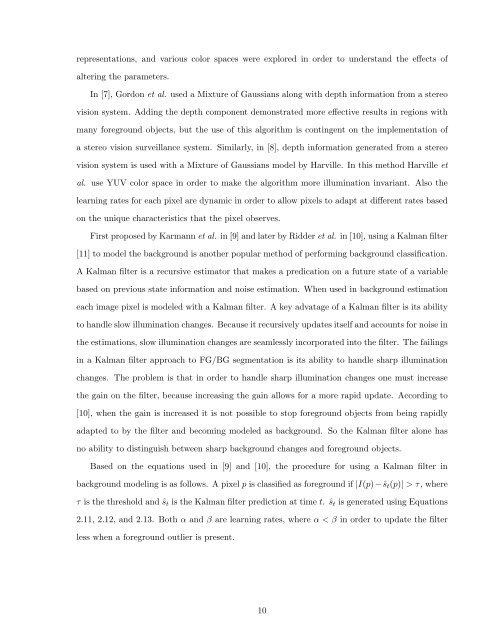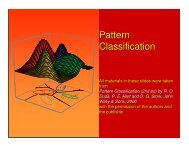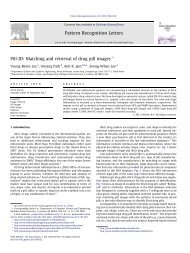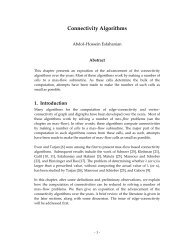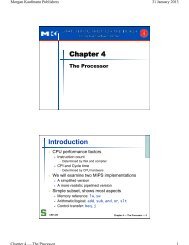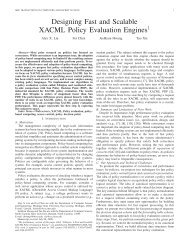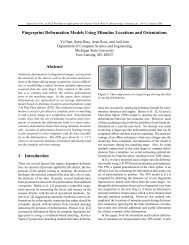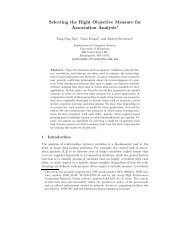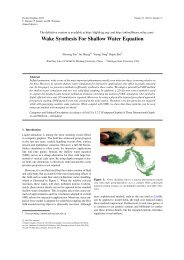Background Subtraction Using Ensembles of Classifiers with an ...
Background Subtraction Using Ensembles of Classifiers with an ...
Background Subtraction Using Ensembles of Classifiers with an ...
You also want an ePaper? Increase the reach of your titles
YUMPU automatically turns print PDFs into web optimized ePapers that Google loves.
epresentations, <strong>an</strong>d various color spaces were explored in order to underst<strong>an</strong>d the effects <strong>of</strong>altering the parameters.In [7], Gordon et al. used a Mixture <strong>of</strong> Gaussi<strong>an</strong>s along <strong>with</strong> depth information from a stereovision system. Adding the depth component demonstrated more effective results in regions <strong>with</strong>m<strong>an</strong>y foreground objects, but the use <strong>of</strong> this algorithm is contingent on the implementation <strong>of</strong>a stereo vision surveill<strong>an</strong>ce system. Similarly, in [8], depth information generated from a stereovision system is used <strong>with</strong> a Mixture <strong>of</strong> Gaussi<strong>an</strong>s model by Harville. In this method Harville etal. use YUV color space in order to make the algorithm more illumination invari<strong>an</strong>t. Also thelearning rates for each pixel are dynamic in order to allow pixels to adapt at different rates basedon the unique characteristics that the pixel observes.First proposed by Karm<strong>an</strong>n et al. in [9] <strong>an</strong>d later by Ridder et al. in [10], using a Kalm<strong>an</strong> filter[11] to model the background is <strong>an</strong>other popular method <strong>of</strong> performing background classification.A Kalm<strong>an</strong> filter is a recursive estimator that makes a predication on a future state <strong>of</strong> a variablebased on previous state information <strong>an</strong>d noise estimation. When used in background estimationeach image pixel is modeled <strong>with</strong> a Kalm<strong>an</strong> filter. A key advatage <strong>of</strong> a Kalm<strong>an</strong> filter is its abilityto h<strong>an</strong>dle slow illumination ch<strong>an</strong>ges. Because it recursively updates itself <strong>an</strong>d accounts for noise inthe estimations, slow illumination ch<strong>an</strong>ges are seamlessly incorporated into the filter. The failingsin a Kalm<strong>an</strong> filter approach to FG/BG segmentation is its ability to h<strong>an</strong>dle sharp illuminationch<strong>an</strong>ges. The problem is that in order to h<strong>an</strong>dle sharp illumination ch<strong>an</strong>ges one must increasethe gain on the filter, because increasing the gain allows for a more rapid update. According to[10], when the gain is increased it is not possible to stop foreground objects from being rapidlyadapted to by the filter <strong>an</strong>d becoming modeled as background. So the Kalm<strong>an</strong> filter alone hasno ability to distinguish between sharp background ch<strong>an</strong>ges <strong>an</strong>d foreground objects.Based on the equations used in [9] <strong>an</strong>d [10], the procedure for using a Kalm<strong>an</strong> filter inbackground modeling is as follows. A pixel p is classified as foreground if |I(p)−ŝ t (p)| > τ, whereτ is the threshold <strong>an</strong>d ŝ t is the Kalm<strong>an</strong> filter prediction at time t. ŝ t is generated using Equations2.11, 2.12, <strong>an</strong>d 2.13. Both α <strong>an</strong>d β are learning rates, where α < β in order to update the filterless when a foreground outlier is present.10


